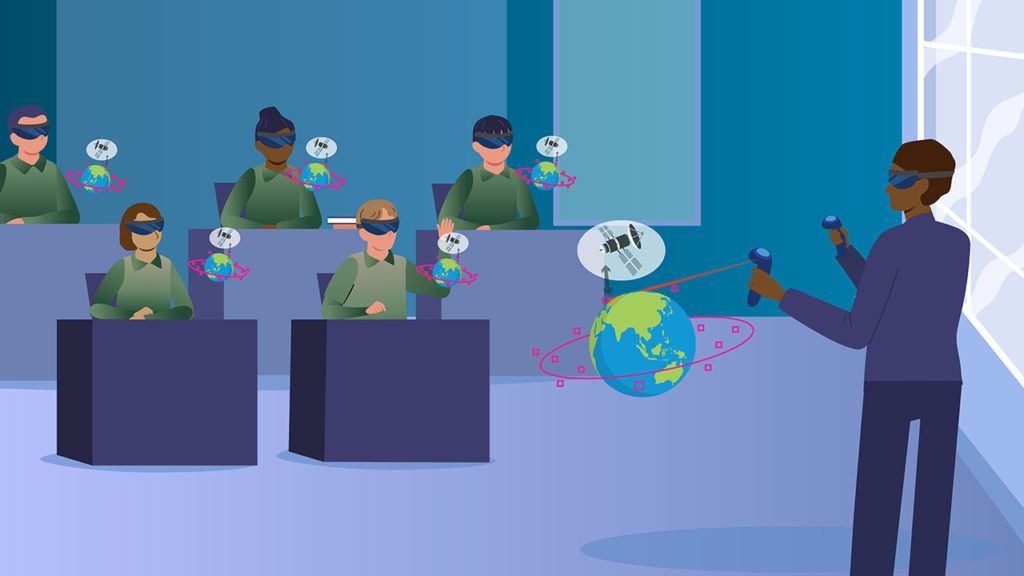Apogee
XR for space domain awareness
XR for space domain awareness
Charles River Analytics has developed extended reality (XR) capability to help Guardians, analysts, and decision-makers visualize and understand space, which is especially important as thousands of satellites travel in various orbital paths in the contested space domain. This XR capability is called KWYN® SOLAR, which is already used in training programs including the Azimuth summer space program.
Apogee expands our work on XR for space domain awareness (SDA) as well as battle management command and control (BMC2).
Satellites and spacecraft are managed and tracked to protect the International Space Station (ISS) and ensure crucial functions on Earth. With the help of KWYN SOLAR, Guardians can more effectively monitor space operations that impact navigation, weather forecasts, television, environmental monitoring, treaty compliance, and communication systems. Now, the Apogee enhancement of KWYN SOLAR will support users in operational training and mission support.

“There is a lot about space that is counterintuitive and not easy to grasp. When people put on the KWYN® SOLAR headset, it goes from ‘oh wow’ to ‘aha’!”

Dr. Susan Latiff
User Experience Scientist and Principal Investigator on the Apogee project
“Space is vast and large, but things happen very quickly,” said Rob Hyland, Director of Program Transition. “This accelerates the speed of decision-making.” To succeed in high pressure, real-time situations on live operations floors, Guardians must achieve sufficient space domain awareness to execute established tactics, techniques, and procedures at the right place and time, and in accordance with rules of engagement.
For Apogee, the team is updating our KWYN SOLAR XR application suite to include upgraded features and customization for various operational environments. The user-friendly tool, navigated through VR headsets such as Magic Leap, presents information in an intuitive way that translates abstract concepts about space into 3D visual representations that operators can understand.
“This type of interactive space operations visualization of complex spatiotemporal relationships in extended reality will improve collaborative, distributed planning of multidomain operations and enable Guardians and analysts to achieve space domain awareness much more quickly and effectively,” said Daniel Stouch, Director of Space and Airborne Systems and Program Manager on the Apogee project.
With Apogee, the team will readily ingest relevant data sources and provide accurate and representative XR visualizations, content, tools, and interaction methods to support the development of dynamic scenarios for operational use. They will demonstrate and deliver the XR tools and infrastructure to develop, edit, save, and play back dynamic XR-based spatiotemporal scenarios to support future operations.


Apogee’s updated networking architecture enables various presentation and collaboration options; e.g., (left)
sharing and interacting with common displays; (right) duplicating a presenter’s view across multiple devices
Guardians will use Apogee to make intelligent, speedy decisions in the space domain from accurate models of resident space objects and their orbital mechanics based on real-time data. Space Force leaders will also use this new tool to detail situations and possible courses of action to help government leaders make informed decisions. Apogee has potential commercial applications in diverse fields, including STEM education (all levels from elementary through graduate courses) with XR-based visualization and interaction with dynamic content in astronomy, astrophysics, Earth science, marine science, and physics.
Contact us to learn more about Apogee and our other adaptive intelligent training, space, and extended reality capabilities.
This material is based upon work supported by the United States Air Force under Contract No. FA8750-23-C-0025. Any opinions, findings and conclusions or recommendations expressed in this material are those of the author(s) and do not necessarily reflect the views of the United States Air Force.
On the job, the KWYN® AI platform augments skills through intelligent guidance and coaching.
